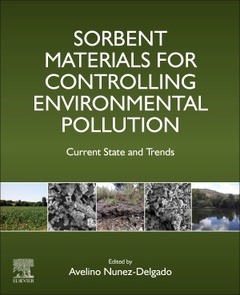Description
Sorbents Materials for Controlling Environmental Pollution
Current State and Trends
Coordinator: Nunez-Delgado Avelino
Language: English
Subject for Sorbents Materials for Controlling Environmental Pollution:
Keywords
Absorption; Activated carbon; Adsorption; Adsorption isotherm; Adsorption mechanisms; Air; Air particulate matter; Air pollution; Amitrole; Anion exchanger; Antibiotics; Antibiotics removal; Arsenic; Biochar; Biocomposites; Biopolymers; Biosorbents; Catalysts; Cations; Chemical crosslinking; Chemisorption; Chitosan; Circular economy; Clay; Clay barrier systems; Clay liners; Clay minerals; CO2 capture technologies; CO2 gas system modeling; CO2 pollution; Composites; Date pits; Decontamination; Degradation; Desorption; Diuron; Emerging pollutants; Europe; Factors; Freundlich; Future trends; Galicia; Grafting; Graphene oxide; Green polymers; Green sorbent; Heavy metals; Hybrid sorbent; Hydrogel; Hydrogels; Impregnated materials; Inorganic; Interactions with adsorbents; Ion-exchange; Iron oxides; Iron-based materials; Langmuir; Low-cost sorbents; Magnetic; Magnetic materials; Maximum capacity; Mechanisms; Metal oxides; Modeling; Morphology; Nanoremediation; Network formation; North Africa; Oil sorbers; Oil spill; Organic; Organic compounds; Organic-inorganic composite; Organogels; Pesticides; Phytoremediation; Pine bark; Pine cone; Pine needles; PM reduction; Pollution; Pollution control; Porous material; Radioactive contamination; Radioactive metals; Radionuclides; RandD; Recalcitrant pollutants; Removal efficacy; Retention of pollutants; Rheology; Scrubber; Soil; Soil pollution; Soil washing; Sorbent; Sorbent materials; Sorbents; Sorption; Sorption on soil; Spain; SUNSPACE; Surface complexation models; Surface properties; Sustainability; Sustainable origin; Swelling; Tetracyclines; Thermal stability; Treatment; Vanadium speciation; VIC; VOC; Waste; Waste gas purification; Waste recycling; Wastewater; Wastewater treatment; Water; Water remediation; Water treatment; Zerovalent iron; Zero-valent iron
776 p. · 19x23.3 cm · Paperback
Description
/li>Contents
/li>Readership
/li>Biography
/li>Comment
/li>
Sorbents Materials for Controlling Environmental Pollution: Current State and Trends presents data on current use and future trends regarding sorbent materials employed against soil, water, and air pollution. The book is organized first by use and research for a variety of geographic areas. It will then focus on different sorbent materials and their uses, followed by various pollutants and their management. Including updated and extensive data from an assortment of sources, the book is organized to be very accessible, including with an interactive table to help identify the results of appropriate sorbents for each environmental compartment.
The growing concern regarding soil, water and air pollution all over the world has implications for climate change and sustainability, making Sorbents Materials for Controlling Environmental Pollution: Current State and Trends an important reference for environmental scientists to identify tools for moving forward in solving these problems.
1. Introduction
Part 1: Global Case Studies 2. Data on the use of sorbents to control pollution in Europe, with main focus on Spain and Galicia 3. Sorbents of heavy metal contamination: Research progress within an Australian context 4. Low-cost sorbents for metal(loid)s removal from mine effluents: an Andean region perspective 5. Current situation and future prospects for the production and utilization of advanced sorbing materials for water depollution in North Africa
Part 2: Sorbents to fight water pollution 6. Removal of pollutants by non-conventional low-cost sorbents 7. Remediation of water polluted with model endocrine disruptors based on adsorption processes 8. The application of pine-based biomass to adsorb potentially toxic elements from aqueous solutions9. Date Pits activated carbon as an effective adsorbent for water treatment 10. Magnetic biochar-based composites for Removal of Recalcitrant Pollutants from Water 11. Biochar as sorbent for organic and inorganic pollutants 12. Iron-based Materials for Removal of arsenic From Water13. Sorbent Hydrogels to Control Heavy Metal Pollution in Water
Part 3: Focus on organic compounds, oil and oil spill compounds 14. Adsorption of organic compounds on activated carbons 15. Organogels as oil sorbents for oil spill treatment 16. Electrospun nanofibers of natural polymer derivatives for oil and water separation 17. Effects of petroleum hydrocarbon on the growth of European aspen and hybrid aspen clones based on stand density
Part 4: Focus on organic compounds: Emerging pollutants and pesticides 18. Synthesis of carbon materials as adsorbents of emerging contaminants 19. insight into adsorption mechanisms of paracetamol onto commercial activated carbon 20. Sorbents for antibiotics removal 21. Pesticides and removal approaches
Part 5: Focus on radioactive elements 22. Application of sorption process for the removal of radioactive elements 23. Role of clay liners in the disposal of radioactive waste 24. Vanadium removal from water by adsorption
Part 6:Sorbents to fight air pollution, or air and water pollution 25. Air pollution control by using different types of sorbents 26. A porous hybrid material for air particulate matter reduction 27. Carbon dioxide as a main source of air pollution: Prospective and current trends to control it 28. Air and Water Pollution Control by Sorbent: Removal of BTEX and heavy metals from air, water and wastewaters by sorbents
Environmental Engineers, Chemical Engineers, researchers of nanomaterials
- Includes data and examples from various geographic locations worldwide
- Synthesizes data for a variety of sorbent material from different sources
- Presents data for various kinds of pollutants across environmental spheres, including soil, water, and air
- Utilizes an interactive table for quicker access to data and results




